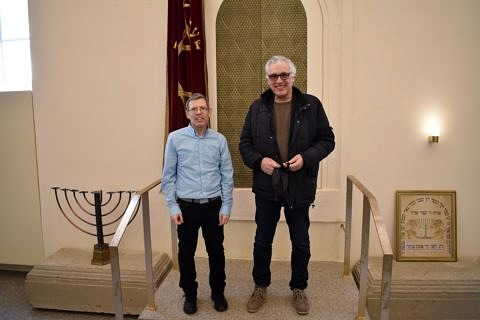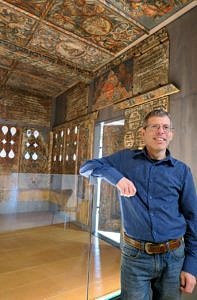Jewish Art Historian Dr. Zvi Orgad visits FAU´s Chair for Bavarian and Franconian Regional History

It is not a coincidence that the Franconian city of Fürth, next to Erlangen and FAU, used to be called “das fränkische Jerusalem” – the Franconian Jerusalem. In the 18th century, the city used to be one of the spiritual capitals of the European Jews. An important reason for this was the Yeshiva, which was established there in 1657: One of the most important universities for the study of the Talmud in Europe, alongside the important educational institutions in Frankfurt and Prague.
Therefore, it is not surprising that the region around Fürth, Erlangen and Nuremberg has a rich Jewish heritage, which attracts international researchers – such as Dr. Zvi Orgad from the Jewish Art Department at the Bar-Ilan University in Ramat Gan, Israel. In his research, Dr. Orgad is interested in Jewish Art.
In February 2019, Dr. Orgad visited FAU´s Chair for Bavarian and Franconian Regional History as well as the Jüdische Museum Franken (Jewish Museum Franconia) in Fürth and its dependence in Schnaittach to talk about a possible collaboration between the Jewish Art Department at his home university, FAU and the museum. In our interview, Dr. Orgad tells us about his expectations regarding the visit.
In the frame of the ERASMUS+ exchange programme, you chose FAU´s Chair for Bavarian and Franconian Regional History for your visit. Why?
My focus in this ERASMUS+ exchange programme was on Jewish visual art, as part of Jewish life in Franconia. These issues cannot be separated from the history, and relations between Jews and Christians, in this region. Prof. Seiderer, who holds the Professorship for Modern Bavarian and Franconian History and Folklore at FAU, is an expert in this topic, as well as a senior faculty member at FAU, with whom I am interested in future academic cooperation.

You would like to set up a summer course. What is the target audience of this summer course? How should the course be structured in terms of content and what goals are pursued with the course?
In the forthcoming summer, I intend to organise a workshop in collaboration with the Jüdisches Museum Franken and FAU. In the frame of this workshop I would like to expose Israeli, and possibly German, students to Jewish visual culture in Franconia. The target audience of the summer school is doctoral students from Bar-Ilan University, and possibly students from FAU who can read Hebrew. The main goal is to expose the students to Jewish visual culture in Franconia. The course will be structured of theoretical and practical components. The theoretical contents of the course will include lectures on Christian and Jewish cultures and history in Franconia, related activities in the Jewish museum library, and excursions to Jewish synagogues, museums and meetings with Jewish communities in Franconia. The practical studies will be based on visits to the museum’s collections, exhibitions and archives. The students will help to organize and catalog archival materials such as wimpels and Genizah in the museum.
You are also interested in a collaboration with the Jüdisches Museum Franken (Jewish Museum Franconia) in Fürth. What do you hope for the cooperation?
The planned summer school would highly benefit from the museum’s resources, including visiting its exhibition, reviewing archival materials, and using the library and seminar rooms. Israeli doctoral who will be exposed to the Jüdisches Museum Franken may want to take a longer ERASMUS+ internship in the museum in the future.
Thank you very much for participating in this interview, Dr. Orgad.